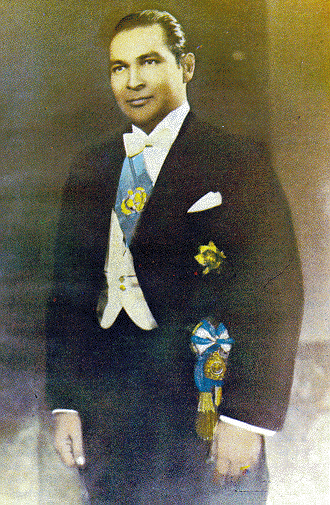Fulgencio Batista
Fulgencio Batista was a Cuban politician who ruled as a dictator from 1952-1959. He was toppled during the Cuban Revolution of 1959.
Batista was born on 16 January 1901 in Oriente province, Cuba, into a poor family. Batista joined the army in 1921. By 1933 he had been promoted to the rank of sergeant stenographer.
In September 1933 Batista played an important role in the military coup against President Machado, a member of the Liberal Party of Cuba. America accepted this coup. The American ambassador even said to Batista that he was the only man in Cuba who held any form of “personal authority”. On 19 January 1934, America recognised the new government of Cuba. From 1934 to 1940, Batista was the driving force behind a series of puppet presidents.
One opponent to his power was Antonio Guiteras, who founded a student movement against Batista’s rule. In 1935 he was murdered, probably by government gunmen, while many other opponents were assassinated or threatened into silence.

In 1940 Batista won the general election and became President. He was the first non-white Cuban to become president.
Batista continued to build up American support. In 1944 he brought in war taxes to help fund America’s war effort. This was an unpopular move in a country where many people suffered from poverty. After serving his term as President, he moved to the Dominican Republic in 1944, then Daytona Beach, Florida. From here he ran a campaign to return to Cuban politics and in 1948 he won a seat in the Cuban Senate.
Batista ran for president again in 1952. However, he was predicted to do very badly; some polls even put the former President in last place. To avoid abject humiliation, Batista headed another military coup. On 10 March 1952 this was successful. America quickly recognised his positioning office and his government on 27 March.
Batista promoted himself to General and went on to suspend the island’s constitution and establish a one-party dictatorship.
Under Batista’s oppressive rule, little was done to help the poor, but he rewarded those on the island who gave him ‘favours’. Cuba, which is situated just fifty mile from Florida, become a playground for America’s rich. Rich Americans flew to Havana to gamble and enjoy the city’s entertainments. Celebrities like Ava Gardner and Frank Sinatra visited.
Beyond these gilded social circles, opposition was mounting against Batista. On 26 July 1953, a group attacked the Moncada barracks, near Santiago del Cuba. The attack was led by Fidel Castro, who lost 60 supporters. Castro was arrested and sentenced to 15 years in prison. Batista responded to the attack with his infamous ‘10 for one’ command. The local military commander was told to shoot ten civilians for every soldier killed. 19 soldiers were killed, so had this order been fully followed through, 190 civilians would have died. A total of 59 were in fact killed.
Batista feared that social unrest would dissuade would-be investors from injecting money into Cuba. He had a lot to lose. It is thought that he took 30 per cent of the money generated in Havana’s many gambling hotels which were run by the Mafia; his wife took 10 per cent. Because the money-flow in such hotels was so great, the 60 per cent left over would still have represented a large profit.
By May 1955, Batista felt confident enough to release Castro and his fellow rebels from the 1953 attack.
Batista faced the mounting problem of Fidel Castro’s left-wing movement from December 1956. By 1956, student riots and anti-Batista demonstrations had become frequent, and unemployment became a problem as graduates entering the workforce could not find jobs.
Castro and his men copied the tactics of the Chinese communists and Mao Zedong. They assisted the island’s poor by helping out on their farms, establishing basic schools and giving medical aid. This ‘hearts and minds’ policy enjoyed great success. Support for the Communists spread beyond the Sierra Maestra Mountains towards Batista’s power base in Havana.
The Cuban Army eventually withdrew their support for Batista and on 31 December 1958 he was forced to flee to the Dominican Republic.
Batista died of a heart attack on 6 August 1973 in Spain, two days before, allegedly, a team of assassins from Castro's Cuba could carry out a plan to assassinate him.
See also: Fidel Castro
MLA Citation/Reference
"Fulgencio Batista". HistoryLearning.com. 2026. Web.
Key facts
| Name: | Fulgencio Batista(Born Fulgencio Batista y Zaldívar) |
| Birth Date: | 16 January 1901, Banes, Cuba |
| Death: | 6 August 1973 (aged 72), Marbella, Spain |
| Spouse(s): | Elisa Godínez Gómez (1926-1946, divorced) Marta Fernandez Miranda(1946-1973, his death) |
| Political Affiliations: | Democratic Socialist 1940-1948 United Action 1948-1950 Progressive Action 1950-1959 |
| Key Appointments: |
President of Cuba
|
